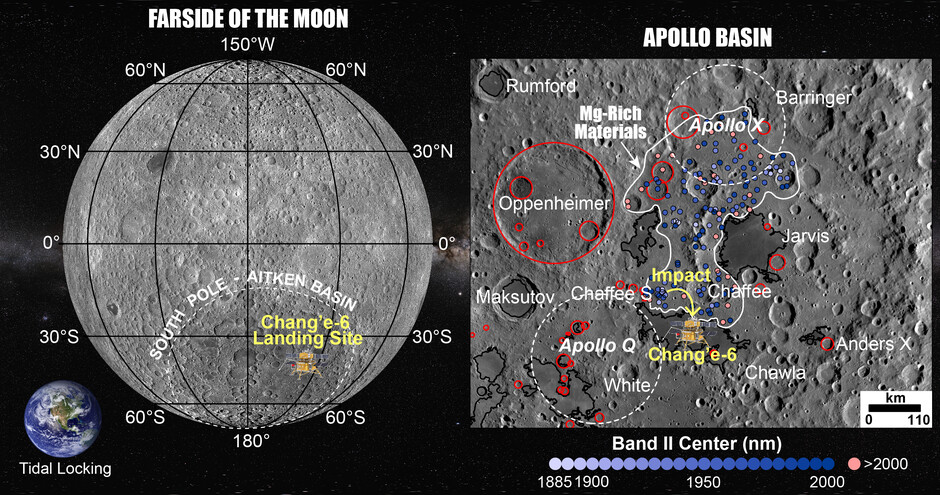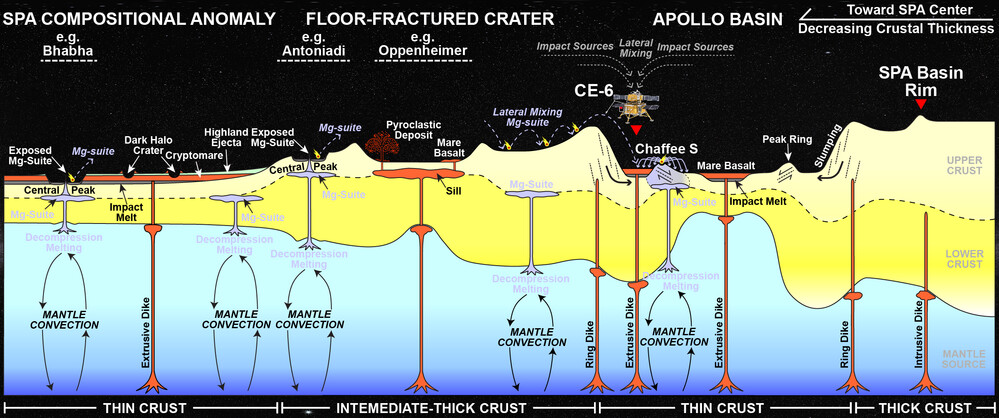27 Aug 2024
HKU Geologists Discover Hidden Magmatism at the Chang'e-6 Lunar Landing Site, Shedding Light on Solving Fundamental Scientific Questions Relating Early Evolution of the Moon

Figure 1. Chang’e-6 landing site locates to the southern Apollo basin in the northeast of the South Pole-Aitken basin, lunar farside. (Image Credit: Y. Qian)
Lunar igneous activities including intrusive and extrusive magmatism, and their products contain significant information about the lunar interior and its thermal state. Their distribution is asymmetrical on the nearside and farside, reflecting the global lunar dichotomy. In addition to previously returned lunar samples all from nearside (Apollo, Luna, and Chang’e-5), samples from the South Pole-Aitken (SPA) basin on the farside have long been thought to hold the key to rebalancing the asymmetrical understandings of the Moon and disclosing the lunar dichotomy conundrum.
Earlier this year, the Chang’e-6 mission of the Chinese Lunar Exploration Program, successfully launched on May 3, landed on the lunar surface on June 2, and returned to the Earth on June 25 carrying a total of 1935.3g of lunar soils. It is the world’s first lunar farside sample-return mission, which landed in the south of the Apollo basin within the SPA basin on the farside. These precious samples would open a window to solve the long-standing question of lunar dichotomy, even reshape human’s knowledge of our closest neighbour. However, compared with the well-known mare volcanism surrounding the Chang’e-6 landing site, the intrusive magmatic activities have a much more obscure presence and origin, impeding future sample analyses when they are available for application.
In a recent research paper published in The Astrophysical Journal Letters, Dr Yuqi QIAN, Professor Joseph MICHALSKI and Professor Guochun ZHAO from the Department of Earth Sciences at The University of Hong Kong (HKU) and their domestic and international collaborators have comprehensively studied the intrusive magmatism of the Chang’e-6 landing site and its surroundings based on remote sensing data. The study revealed their extensive distributions and obscure nature with significant implications for the petrogenesis of lunar plutonic rocks and the Chang’e-6 mission, which will facilitate scientists’ further study of lunar farside.
Key Findings
The study has found that intrusive magmatism is widespread in the SPA basin. They occur in various forms including sills beneath floor-modified craters, linear and ring dikes shown by gravity data, and Mg-suite intrusions with characteristic spectral absorptions. These observations agree with the intermediate-thick crust of SPA where intrusion is favored. Landing in the SPA basin, Chang’e-6 likely collected plutonic rocks, excavated and transported by adjacent impact craters to the sampling site, that could be examined by the ongoing sample studies. They have discovered two heavily degraded floor-fractured craters (see Apollo X and Apollo Q craters in Figure 1), inspiring to identify more similar features on the Moon. All indicate that intrusive magmatism is abundant in the Chang’e-6 sampling region.
This study has traced potential plutonic materials in the Chang’e-6 samples and found that Mg-suite materials highly likely exist, primarily from the western peak ring of the Apollo basin delivered by Chaffee S crater. These Mg-rich materials contain crucial information on the origin of mysterious KREEP-poor Mg-suite rocks. Samples from both the intrusive and extrusive magmatism from the never sampled farside, especially the mysterious Mg-suite, will shed further light on solving the lunar dichotomy conundrum and a series of fundamental scientific questions relating to secondary crust building and early evolution of the Moon.
Professor Xianhua LI, an academician of the Chinese Academy of Science (CAS), and a leader of China’s lunar sample studies from the Institute of Geology and Geophysics (CAS), said: ‘The results of this research set a significant geological framework to study plutonic rocks in the Chang’e-6 samples, especially Mg-suite rocks.’ Professor Li emphasised: ‘Their petrogenesis and timing are unclear, and this research would dramatically help to understand their origin mechanism.’
‘This research is an excellent example of HKU’s deep involvement in the China's Lunar Exploration Program,’ said Professor Guochun ZHAO, an academician of the Chinese Academy of Science and Chair Professor of Earth Sciences (HKU). ‘Lunar and space exploration programs are an important component of China's goal to become a scientific and technological power, and HKU’s proactive involvement in these programs will bring additional resources for Hong Kong to become an international centre for science and innovation,’ he continued.
HKU is the first university in Hong Kong that possesses lunar samples obtained by the Chang’e-5 mission. Building on the foundation of this work, the geologists from HKU will also pursue opportunities to study Chang’e-6 samples in the future and be more deeply involved in the Chinese Lunar Exploration Program.

Figure 2. Intrusive magmatism is extensive across the South Pole-Aitken basin, whose products highly likely collected by the Chang’e-6 mission.
(Image Credit: Y. Qian)
About Dr Yuqi QIAN
Dr Qian is a planetary geologist from the Department of Earth Sciences and Laboratory for Space Research at HKU. Dr Qian collaborates with domestic and international colleagues to study the geology of terrestrial planets in the Solar System. Dr Qian’s research mainly focuses on lunar geology and explorations based on orbital and rover data and returned lunar samples, especially those of China. Dr Qian has started participating in the Chinese Lunar Exploration Program since 2016 and involved in Chang-5 and Chang’e-6 missions. He has published more than 35 papers with over 800 citations including those in top-tier journals that significantly help to study China’s lunar samples. Dr Qian is the 1st scientist in HK who successfully applied for lunar samples obtained by the nation and conducted research on them.
For more information about Dr Qian, please visit: https://yuqiqian.com.
About Professor Joseph MICHALSKI
Professor Michalski’s research focuses on uncovering discoveries about the volcanology, geochemistry, tectonics, and mineralogy of Mars, by utilising a range of remote sensing data, including infrared, visible, magnetic, gravity, and laser data from satellites orbiting Mars and rovers on its surface. He has established the Planetary Spectroscopy and Mineralogy Laboratory. This cutting-edge facility offers laboratory support for past, current, and future missions to Mars, the Moon, and asteroids in China and beyond. Professor Michalski is the 1st non-Chinese awardee of the Tencent Xplorer Prize and also a RGC Research Fellow. He serves as the deputy director of Laboratory for Space Research at HKU.
For more information about Professor Michalski, please visit: https://joeplanets.com
About Professor Guochun ZHAO
Professor Zhao is a highly esteemed geologist with international recognition, specialising in Precambrian Geology, metamorphic petrology, and tectonics. His contributions to the field, including over 450 scientific papers with more than 69,000 citations, earn him prestigious accolades. He was elected as an academician of Chinese Academy of Sciences in 2019, a fellow of the World Academy of Sciences for the Advancement of Science in Developing Countries in 2021, and a member of Hong Kong Academy of Sciences in 2023. In the 2024 Best Scientists Rankings (Research.com), Professor Zhao stands 8th in the world and 1st in China in Earth Sciences. Professor Zhao is the director of NWU-HKU Joint Center for Earth and Planetary Sciences.
The journal paper can be accessed here: https://doi.org/10.3847/2041-8213/ad698f







